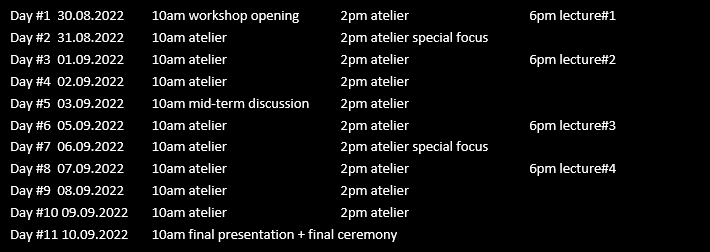
ATELIERS' PROGRAMS Atelier 1. (Karim Nader, Utopia in the Landscape) Focusing on a radically ecological approach, this workshop conducted will imagine a sort of “Utopic Return” to nature, as if nothing had happened. This process of recuperation will initially focus on an in-depth understanding of the native natural systems of the west side of Piacenza, its subsequent transformations, and how a contemporary attitude (in the spirit of Wu-Wei) of ‘pulling back’ from intervention could help re-enliven the natural and original states of those natural ecologies. Punctual architectural interventions, also in line with highly simple, sensitive and eco-friendly attitudes would reconnect the human to the seemingly untouched natural. Agriculture in this context will be imagined as an extension of natural systems rather than an exploitative and ressource intensive concept. Collage, hand-painting and life-drawing will be also encouraged within an ‘on-site’ immersive approach and process. Atelier 2. (Valerio Morabito, Designing Urban Forests) Typically when we think of urban reforestation our ideas are related to the number of trees to be planted, their ecological characteristics, and the amount of spaces available within cities for as much planting as possible. But an urban forest must also have its own formal, aesthetic, and compositional quality. Urban forest spaces must be thought of not only according to ecological or resilient logic. Still, they must be connected to all those aspects of cultural, social, and artistic value that create the idea of urban spaces. The first requirement for the students it to flood, as if it were water, the entire work area with an imaginative utopic massive new planting. After this first quantitative step, students must focus to design the idea of the urban forest places by modifying and adapting the green water according to artistic, aesthetic, and design qualities that consider all the place contradictions, physical and non-physical, tangible and intangible, present in the work area. Atelier 3. (Pedro Campos Costa) The “Via Emilia” it’s much more than an infrastructure. It’s a cultural identity reference, an icon in the representation of a region and of a landscape. Connecting people, villages, cities, agricultural settlements, cultures, the road created a linear city/system along the Emilia Romagna. A strong and very much visible linear territorial structure, oblige us to look at it not in a unique functional sense, but as part of a landscape, urban system with its culture importance. We propose in the atelier to work this infrastructure with a territorial scale as a culture device. So, we challenge the students to create punctual spaces, buildings, or urban devices along the Via Emilia to stop, to see, to inform, to become, to intertwine, to relate nature and culture. The museum is not enough, promoting different approaches to culture dimensions, with the necessary awareness the ecological transition is to be made in the present times. We can transform the present, not the past or the future. The studio is about transformation of the present time. We will ask a collective physical model to project/represent a culture exhibition device along (and within and related with) the infrastructure and integrated into the landscape/nature. With art, with arts and crafts, with industries, with people and with music! This is our music, what is yours? There's a city in my mind Text David Byrne- song road to nowhere Atelier 4. (Antonella Contin, in collaboration with UN-Habitat experts) The Module UN-Habitat MSlab aims to transfer to the participants something related to achieving awareness and participation about sustainable development through the adoption of practices and systemic actions produced by the network of Sustainable Goals called SDGs. The expected learning outcome is achieved by knowing SDGs tool and understanding how to act within the targets and indicators connected with the network of SDGs. The Module educates systemic thinking that recovers the interdisciplinary view of problems to understand reality in global and interconnected ways. Finally, the Module enriches the students' educational experiences through the concrete application on the Summer School Case Study of the contents learned through new theoretical and practical tools. Providing learners with skills to think the complexity will help create more effective SDG implementers thus helping the acceleration of the implementation of all the SDGs. The Module is divided into four phases: Phase 0 is an introduction to the epistemology of the Metropolitan Discipline and deal with the importance of knowledge ecosystem construction to achieve a sustainable development of the contemporary city. Phase 1 is dedicated to the literature on the SDGs and the values underlying this approach. Phase 2 deals with a critical analysis of the SDGs within invited international experts from UNHabitat, which promoted the goals and NUA. Phase 3 introduces the tool to obtain a meta-project necessary to achieve sustainable development identified. This module also includes SDGs tool application that brings together different disciplinary knowledge. |
|||
 di IMG_8036.jpg)
 di P9160090.jpg)
